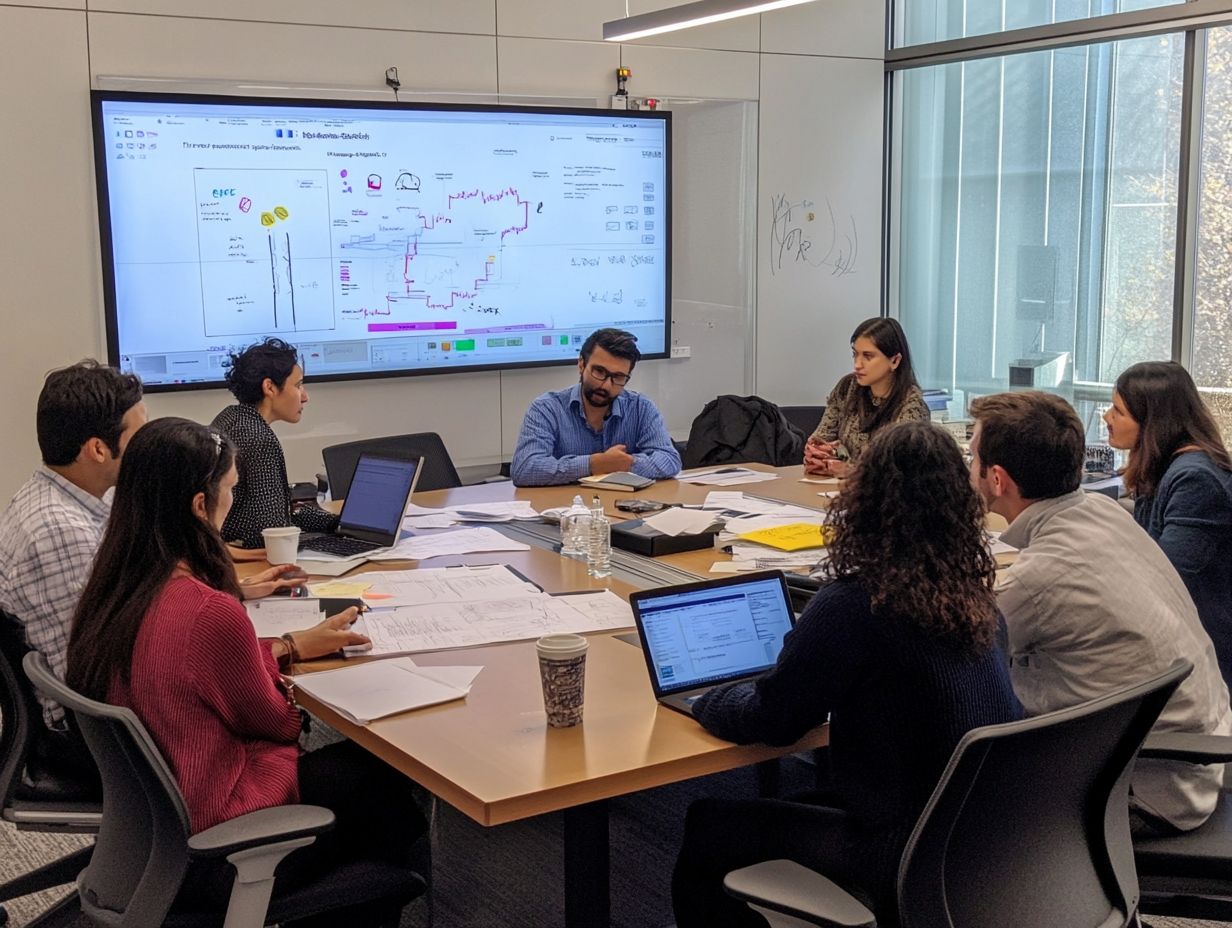strategic planning for incident response
In today s fast-paced digital landscape, your ability to respond effectively to incidents is absolutely crucial for your organization. Incident response goes beyond merely reacting to crises; it encompasses strategic planning and thorough preparation.
This article delves into the essential components of an incident response plan, guiding you through the process of identifying risks, defining roles, and establishing clear communication protocols.
You ll uncover a step-by-step guide to crafting an effective plan, as well as the significance of regular testing and updates.
Equip your organization with the necessary tools to navigate unexpected challenges with confidence and poise.
Contents
- Key Takeaways:
- Key Elements of an Incident Response Plan
- Creating an Effective Incident Response Plan
- Step-by-Step Guide to Developing a Plan
- Testing and Updating the Plan
- Frequently Asked Questions
- What is strategic planning for incident response?
- Why is strategic planning for incident response important?
- What steps are involved in strategic planning for incident response?
- Who is responsible for strategic planning for incident response?
- How often should strategic planning for incident response be reviewed?
- What are some best practices for strategic planning for incident response?
Key Takeaways:

Effective incident response requires strategic planning to mitigate risks and ensure a quick and efficient response. A well-developed incident response plan should include risk identification, defined roles and responsibilities, and clear communication protocols. Familiarizing yourself with the phases of an effective incident response and regularly testing and updating the plan are crucial to ensure its effectiveness in handling potential incidents.
What is Incident Response?
Incident response is how your organization plans to handle unexpected security breaches, ensuring the protection of your data, reputation, and operations against security events like data breaches.
In today s digital landscape, a well-crafted incident response framework is essential for minimizing risks and enabling swift recovery. This framework is vital for your cybersecurity strategy. It helps your teams detect, analyze, and mitigate threats efficiently.
An incident response team, made up of skilled professionals, is key in this arena. They develop protocols tailored to identify and address a variety of incidents, such as malware attacks, phishing schemes, and ransomware incidents.
The consequences of an inadequate response can be severe. It can result in significant financial losses, legal issues, and long-lasting damage to your brand s reputation.
Therefore, having an agile and competent incident response team can dramatically enhance your organization s resilience against cyber threats. This fosters a proactive security posture that keeps you a step ahead.
The Importance of Strategic Planning
Strategic planning serves as the cornerstone of effective incident response, providing you with a solid framework to identify, classify, and tackle various cybersecurity incidents. Understanding the role of leadership in incident response ensures that your incident response plans are tailored to specific scenarios, positioning your organization to react proactively.
This enhances incident management and minimizes the overall impact of security events. This structured approach speeds up detecting and resolving security threats.
By categorizing incidents based on their severity and potential impact, you can prioritize threats effectively. This allows you to allocate resources more efficiently, ensuring that high-priority incidents receive prompt attention.
Clear and effective communication procedures are essential. They foster collaboration among stakeholders and ensure that every team member comprehends their role during an incident.
This cultivates an atmosphere of preparedness and responsiveness, ultimately fortifying your organization s resilience against future cybersecurity challenges.
Key Elements of an Incident Response Plan
An effective incident response plan encompasses several essential components, such as the preparation phase, incident detection capabilities, containment strategies, and a clearly defined incident response process.
Each of these elements is crucial for enabling you to respond swiftly and efficiently to a range of cybersecurity incidents. Ultimately, this reduces both financial loss and reputational harm.
Don’t wait for a breach to hit. Equip your organization now with a robust incident response plan to stay ahead of cyber threats!
Identifying and Assessing Risks

Identifying and assessing risks is crucial in your incident response process. It helps you understand the potential impacts of cybersecurity incidents based on their severity and frequency.
Using threat intelligence, you can prioritize your incident management strategies. This effectively reduces risks.
Advanced tools, like risk assessment frameworks and automated vulnerability scanners, provide deeper insights into weaknesses in your systems. These tools offer real-time data and actionable insights.
Address vulnerabilities before they turn into serious threats. Understanding incident severity helps shape response strategies; not every incident needs the same urgency or resources.
By categorizing incidents based on their impact whether minor disruptions or major breaches you can allocate appropriate resources. This method ensures efficient handling of cybersecurity threats.
Defining Roles and Responsibilities
Clear roles and responsibilities within your incident response team are essential for effective coordination during a cybersecurity incident. Assign an incident commander and define tasks among the DevOps and IT support teams for a structured response.
The incident commander oversees operations, makes key decisions, and directs the team to mitigate risks. Establishing procedures and protocols streamlines workflows and clarifies communication.
Collaboration between DevOps and IT support teams is crucial. Together, they can quickly identify vulnerabilities and respond to threats.
This teamwork encourages open dialogue, leading to real-time updates and problem-solving. Effective communication aligns everyone and enhances response efficiency.
Establishing Communication Protocols
Effective communication protocols are vital for managing incident response. They shape information flow among stakeholders during an incident and during post-incident analysis.
Clear reporting and communication procedures enhance collaboration and meet legal obligations, fostering trust with customers. Develop a structured communication plan before, during, and after an incident.
Designate roles for incident reporting to ensure critical information reaches relevant parties, including regulatory bodies. Utilize digital platforms for real-time updates, keeping stakeholders informed and engaged.
After the incident, conducting debriefs to assess communication effectiveness will highlight areas for improvement. This process strengthens legal compliance and builds customer confidence.
Creating an Effective Incident Response Plan
Creating an effective incident response plan requires more than a quick look at the current cybersecurity landscape. It demands strong security measures and a clear recovery plan.
Investing in regular incident response training ensures your teams are prepared. This proactive approach enhances readiness and helps you measure vital incident response metrics.
Step-by-Step Guide to Developing a Plan

A step-by-step guide to developing a robust incident response plan includes identifying key stakeholders and defining the incident response process. Additionally, understanding the importance of incident response policies involves creating effective templates tailored to specific scenarios.
Utilizing security monitoring tools tools that help detect and respond to security threats quickly and outlining procedures for incident remediation are also essential components of a comprehensive plan.
To kick off this process, you must conduct initial assessments to grasp your current security posture, allowing you to develop tailored strategies. Involving key team members, such as IT and cybersecurity experts, is crucial for crafting an effective response framework.
Every step, from detection and analysis to containment and eradication, should be meticulously documented to enhance clarity and accountability. Integrating security monitoring tools provides real-time insights, helping you quickly identify potential threats.
After the initial phases, ensure that remediation procedures are clearly defined, with roles assigned and actions prioritized for optimal effectiveness in the face of incidents.
Testing and Updating the Plan
Regularly testing and updating your incident response plan keeps it effective and relevant in the ever-evolving landscape of cybersecurity threats. This practice ensures that your strategy aligns with the latest security frameworks and methodologies.
By integrating incident response training and leveraging lessons learned from previous incidents, your organization can consistently enhance its response capabilities. Regular evaluation of incident response metrics helps to identify gaps and continuously refine your approach to incident management.
Tabletop exercises are an effective way for your team to walk through potential scenarios in a controlled environment, allowing you to test communication and decision-making skills without the immediate pressures of a real incident. Simulation drills offer a more dynamic experience, facilitating practical application of the incident response plan under stress.
These methodologies not only enhance your preparedness but also help identify specific metrics to analyze after each exercise. By meticulously documenting these metrics, you can pinpoint weaknesses and make necessary adjustments to your response strategies, ultimately strengthening your overall security posture.
Frequently Asked Questions
What is strategic planning for incident response?

Strategic planning for incident response is the process of identifying potential risks and developing a plan to mitigate and respond to these incidents. Understanding what is incident response planning can help minimize their impact on an organization.
Why is strategic planning for incident response important?
Strategic planning helps organizations prepare for incidents, reducing their likelihood and impact.
What steps are involved in strategic planning for incident response?
The steps typically include risk assessment, development of a response plan, testing and training, and continuous evaluation and improvement. It is recommended to review and update the plan regularly, especially when there are changes in the organization’s environment or operations.
Who is responsible for strategic planning for incident response?
It should involve a team of individuals, including senior leadership, IT and security personnel, and representatives from different departments within the organization.
How often should strategic planning for incident response be reviewed?
Strategic planning should be reviewed at least annually, but regular updates are recommended to ensure its effectiveness.
What are some best practices for strategic planning for incident response?
Involve key stakeholders in the planning process. Their input is vital for a robust strategy.
Regularly check for potential risks. This helps you identify vulnerabilities before they become problems.
Testing and training your response plan is crucial. Regular practice prepares your team for real incidents.
Always evaluate and update your plan to stay prepared. This ensures you adapt to new threats and changes in your environment.






